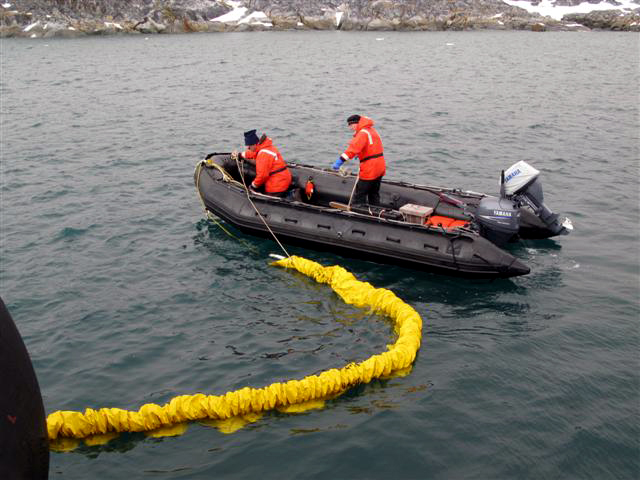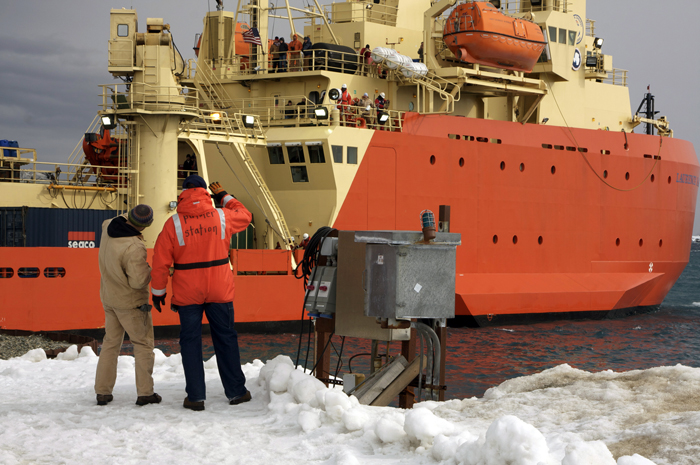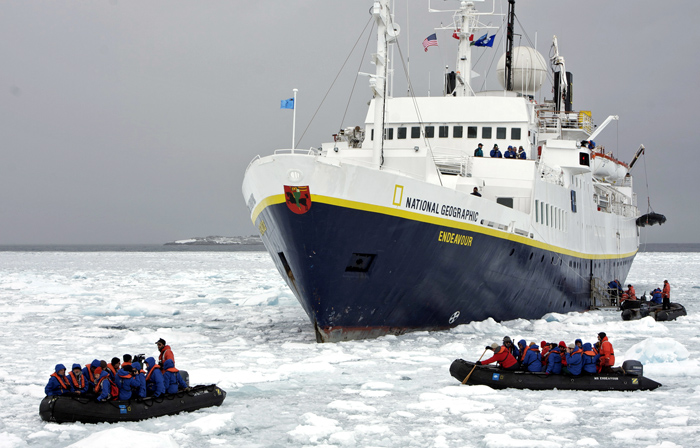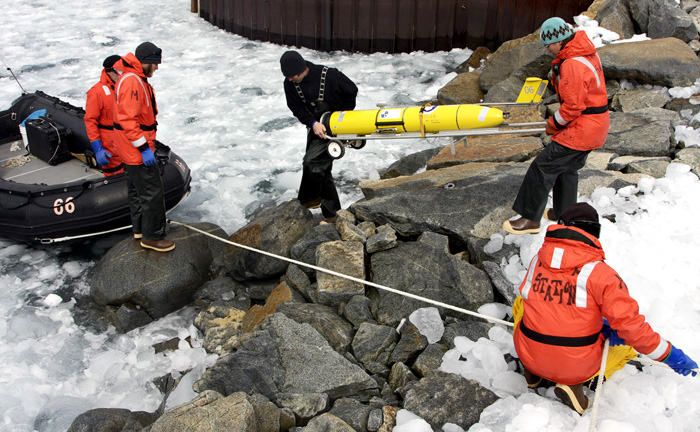|
Palmer Station Archives - 2008 Tourist season under way at PalmerPosted December 19, 2008
“It’s diving!” was announced as the torpedo-esque glider descended into the cold water. The bright yellow color was visible for a few moments before disappearing out of sight, hopefully for the next several weeks if all goes as planned. Principal Investigator Oscar Schofield’s team is at Palmer Station “The Birders,” Bill Fraser’s seabird researchers, have jumped at every window of good weather to get out in the field. Their work takes them to almost every nearby island to monitor the behavior and breeding patterns of a wide variety of Antarctic seabirds, continuing decades of research conducted by Fraser. [See article: Local extinction.] They’ve been banding and recording giant petrels and skuas, performing a full census of the gull population and maintaining their observations of nesting penguins. On nearby Torgesen Island, Adélie eggs have begun hatching, and the faint peeping of the small chicks has the Palmer community smiling like proud parents. The RVIB Nathanial B. Palmer Recent Thursday evening science lectures have covered the work of both of our resident science groups; impressions of current events in Pakistan; and Kwajalein Atoll and its strategic role in WWII. We were even treated to an update of recent discoveries in our solar system by resident research associate and NASA Tourist cruise ships are now our most common visitors, with an average of about one a week. Our guests seem thrilled to receive a quick tour of the station and learn about the science and research being conducted here. [See related article: Tourism influx and the sidebar Cruising around.] Thanksgiving was marked by a rare two-day weekend that began with a meal fit for royalty. All 25 of us sat at one long table stretching the length of the dining hall and feasted family-style on two roasted turkeys with all of the fixings. The following night we celebrated further with an open mic night in the Boathouse full of live music and storytelling. Looking to the future, the New Year will bring the ARSV Laurence M. Gould Palmer prepares for long summer isolationPosted November 14, 2008

Photo Credit: Rebecca Shoop/Antarctic Photo Library
Palmer Station's spill response team perform a drill on the water.
The summer season is in full swing at Palmer Station This unusually long period between cruises has some referring to our isolated months as a “mini-winter.” Fresh vegetables will be scarce for the upcoming major holidays, and we had to send any outgoing gifts in September. Despite this, the 26 of us who remain don’t seem to mind and are enjoying a station with only just over half of its usual summer population. Science is going strong with two groups with the Palmer Long Term Ecological Research (LTER) 
Photo Credit: Jon Brack
The ARSV Laurence M. Gould makes its last port call at Palmer Station until January.
With a pair of shiny yellow underwater gliders, the phytoplankton group with new LTER principal investigator Oscar Schofield, is preparing for their first launch in a couple of weeks. The bulk of their work will take place during the LTER cruise in January when the gliders will journey hundreds of miles south along the peninsula towards Rothera Station. [See related story: Below the surface.] For now, Schofield’s team is preparing and testing their equipment to determine the feasibility of using their science package in icy waters. The artist-in-residence, Scott Sternbach All station safety teams have completed initial drills with their summer crews. The spill response team successfully deployed the containment boom last week during a drill. This week the glacier search and rescue (SAR) team practiced self-arrests on a nearby glacier and the trauma team practiced their needlework with blood-testing procedures. Ocean SAR is constantly on the ready as the science groups travel throughout the nearby islands and on the water collecting their data. The new month means another fire drill is surely in the works and will likely surprise everyone with yet another mock emergency for the volunteer crew to tackle and learn from. Outside of work hours, a recent Halloween party attracted almost everyone on station, including Fidel Castro, Cleopatra and even Hermey the Misfit Elf. A string of nice weather and more daylight after work has allowed for skiing on the glacier and games of Frisbee golf in the backyard. The first tour ship visit is only two weeks away, so tour guide training will soon be in full swing to prepare for the arrival of happy visitors. [See related article: Tourism influx and the sidebar Cruising around.] The 26 of us will surely stay busy for the couple of months between boats as days continue to get longer and warmer. Crew swaps out at PalmerPosted September 26, 2008
McMurdo Station usually takes all of the fanfare that accompanies a new field season in Antarctica. But at Palmer Station, some personnel are swapping out as summer officially kicks off on the Antarctic Peninsula. The swap happens twice per year — once for the summer season and once for the winter. The transition was busy but smooth, according to Eric Pohlman, outgoing Palmer winter site manager. "It's chaos but a good chaos," he said. The five-day port call by the ARSV Laurence M. Gould also included the delivery of fuel. More than a dozen support personnel switched out jobs. Some positions only take a few days of turnover, while others, such as the medical doctor, require longer transitions, meaning outgoing employees will not leave until the Gould returns later in October, Pohlman explained. The transition also requires turning over the station's volunteer fire brigade, search and rescue team, and ocean search and rescue team. "We pretty much do a [fire] drill, and then the new team [is on the job]," Pohlman said. Palmer did find time in the hectic few days for the winter-over medal ceremony, when those who have spent the dark and cold months in Antarctica receive recognition of their service. "It's kind of unique for a middle manager to give out medals," Pohlman mused. It continues to be a relatively dry year at Palmer Station, according to an August weather report by the station’s research associate Payot Scheibe. Despite a 24-hour dump of about 30 centimeters (nearly a foot) of snow in August, snowfall for the month still came in at 46 centimeters. The total accumulation for the year, 193 centimeters, is well below the historical average of 246 centimeters. August also marked the first sea ice around Palmer Station for the season. Christopher Seliga, winter assistant supervisor of laboratory operations, reported numerous birds were seen during the month, including blue-eyed shags flying in large flocks or congregating on various islands. Other commonly seen birds around Palmer Station in August were giant petrels, sheathbills, kelp gulls and Antarctic terns. The only penguin sightings have been some gentoos spotted in the waters early in the month, before the sea ice set in. |
Home /
Around the Continent /
Palmer Station Archives - 2008
"News about the USAP, the Ice, and the People"



For USAP Participants |
For The Public |
For Researchers and EducatorsContact UsU.S. National Science FoundationOffice of Polar Programs Geosciences Directorate 2415 Eisenhower Avenue, Suite W7100 Alexandria, VA 22314 Sign up for the NSF Office of Polar Programs newsletter and events. Feedback Form |



